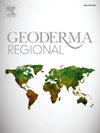Vegetation type and Fe and Al oxides are important factors influencing the spatial distributions of soil organic carbon and mineral-associated organic carbon in mountain ecosystems
IF 3.3
2区 农林科学
Q2 SOIL SCIENCE
引用次数: 0
Abstract
In mountain ecosystems, changes in elevation can lead to alterations in regional microclimates, thereby affecting the distribution and transformation of soil organic carbon (SOC). Mineral-associated organic carbon (MOC) plays a crucial role in preserving SOC. However, research on the distribution of SOC and MOC content in mountain ecosystems is limited. Therefore, we conducted correlation analysis to analyze the effects of environmental factors (mean annual temperature and precipitation, elevation, and vegetation) and soil oxides (SO) on the contents of SOC and MOC in the Wuling Mountain. Selective dissolution methods have been used to further extract soil carbon (C) associated with Al and Fe minerals, as well as extractable Al and Fe. The results indicated that temperature and precipitation are important drivers of changes in the SOC and MOC contents. Moreover, the changes in the SOC and MOC contents were the result of the combined effects of multiple factors, such as climate, elevation and vegetation. There was a significant difference in the organic C stock among the different vegetation types: mixed coniferous broad-leaved forest > subalpine meadow > broad-leaved forest > shrubland-grassland. Not only were the Fe2O3 and Al2O3 contents in SO significantly correlated with SOC and MOC contents, but the extractable Fe and Al contents were also positively correlated with the extractable C content. The extractable Al and Fe contents increase with soil depth, whereas the MOC content decreases and the MOC/SOC ratio increases. Therefore, we speculated that the content of minerals such as Al and Fe in surface soils determines the MOC content, whereas in deeper soils the content of organic matter determines the content of MOC. Our research results emphasize that Fe and Al minerals promote SOC sequestration in mountain soils, which is important for understanding soil C cycling and predicting changes in SOC stocks in mountain soils.
植被类型和铁、铝氧化物是影响山地生态系统土壤有机碳和矿物伴生有机碳空间分布的重要因素
在山地生态系统中,海拔的变化会导致区域小气候的变化,从而影响土壤有机碳(SOC)的分布和转化。矿物伴生有机碳(MOC)在维持有机碳中起着至关重要的作用。然而,对山地生态系统中有机碳和MOC含量分布的研究较少。为此,我们通过相关分析分析了环境因子(年平均气温和降水量、海拔、植被)和土壤氧化物(SO)对武陵山土壤有机碳和MOC含量的影响。选择性溶解法用于进一步提取与Al和Fe矿物相关的土壤碳(C),以及可提取的Al和Fe。结果表明,温度和降水是土壤有机碳和MOC含量变化的重要驱动因素。土壤有机碳和MOC含量的变化是气候、海拔和植被等多种因素综合作用的结果。不同植被类型间有机碳储量存在显著差异:混交林和阔叶林;亚高山草甸>;阔叶林;shrubland-grassland。SO中Fe2O3和Al2O3含量不仅与SOC和MOC含量显著相关,而且可提取Fe和Al含量也与可提取C含量呈正相关。可提取Al和Fe含量随土壤深度的增加而增加,MOC含量降低,MOC/SOC比值增加。因此,我们推测表层土壤中Al、Fe等矿物质的含量决定MOC含量,而深层土壤中有机质的含量决定MOC含量。我们的研究结果强调了Fe和Al矿物促进了山地土壤有机碳的固存,这对了解土壤C循环和预测山地土壤有机碳储量变化具有重要意义。
本文章由计算机程序翻译,如有差异,请以英文原文为准。
求助全文
约1分钟内获得全文
求助全文
来源期刊

Geoderma Regional
Agricultural and Biological Sciences-Soil Science
CiteScore
6.10
自引率
7.30%
发文量
122
审稿时长
76 days
期刊介绍:
Global issues require studies and solutions on national and regional levels. Geoderma Regional focuses on studies that increase understanding and advance our scientific knowledge of soils in all regions of the world. The journal embraces every aspect of soil science and welcomes reviews of regional progress.
 求助内容:
求助内容: 应助结果提醒方式:
应助结果提醒方式:


